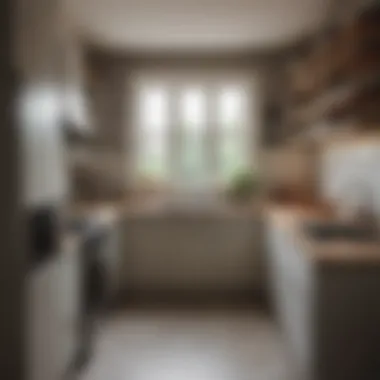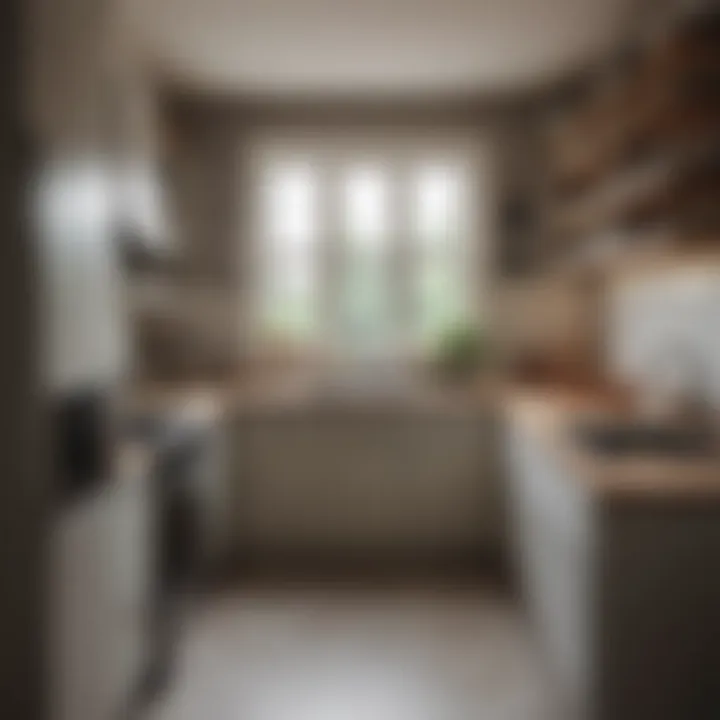Transforming Tiny Kitchens: Smart Makeover Ideas


Intro
In a world where space is increasingly becoming a luxury, many homeowners confront the challenge of designing functional and attractive kitchens within limited areas. The kitchen, often viewed as the heart of the home, should neither feel cramped nor sacrificed for style. Instead, with strategic planning and thoughtful design, it is possible to create an inviting and efficient tiny kitchen that serves both culinary and social needs. This guide provides a comprehensive overview of how to maximize small kitchen spaces while keeping aesthetics in mind. From choosing the right materials to clever organization techniques, we will explore essential strategies to rejuvenate your culinary environment.
Design Inspiration
Trending Styles
The design landscape for small kitchens is dynamic, with trends often prioritizing functionality alongside visual appeal. One popular style is minimalism, which emphasizes simplicity and the elimination of clutter. This approach utilizes sleek cabinetry and clean lines, making the space appear larger. Furthermore, industrial designs gain traction as they incorporate raw materials like metal and wood, creating an urban aesthetic perfect for small kitchens.
Another emerging trend is Scandinavian design, known for its focus on light color palettes and natural materials. This style not only brightens up the space but also fosters an airy atmosphere, which is crucial in small areas. These options highlight the versatility in design, allowing homeowners to personalize their kitchens according to their tastes.
Color Palettes
Color selection plays a critical role in small kitchen makeovers. Bright colors such as whites or soft pastels enhance the perception of space and light. Sage green or powder blue introduces a soothing element that pairs well with natural wood finishes.
On the other hand, bold accents can also be an effective strategy to create visual interest. For instance, a deep navy or a rich charcoal can serve as an effective backdrop that makes lighter elements stand out, breaking away the monotony. It is important to balance these color choices to ensure they contribute positively to the overall atmosphere without overwhelming the space.
Remember: Colors can transform the ambiance and functionality of your kitchen significantly. Choose wisely to align with your design vision.
Practical Tips
Maintenance & Care
Keeping a tiny kitchen beautiful requires mindful maintenance. Regular cleaning is essential, particularly for surfaces that endure heavy use, such as countertops and stovetops. Opt for materials that are easy to clean, such as quartz or stainless steel. Additionally, consider incorporating splashbacks that are both functional and decorative, adding to the kitchen's overall aesthetic while protecting walls from stains.
Budgeting & Planning
Before embarking on a kitchen makeover, establishing a clear budget is crucial. Setting realistic financial boundaries helps prioritize necessary upgrades while also allowing for splurges on design elements that truly enhance the space. When planning, list out essentials and desired upgrades. For instance, consider investing in compact appliances that maximize functionality without taking up too much counter space. DIY projects can also significantly cut down costs, enhancing the budget-friendliness of the makeover process.
Incorporating clever storage solutions like pull-out shelves or hidden compartments is essential in small kitchen design, enabling homeowners to optimize every inch of available space.
By employing these strategies, your tiny kitchen can evolve into a well-organized and stylish space, perfectly suited for modern living. Understand the trends, select your colors thoughtfully, maintain your improvements, and plan effectively. These elements combined will offer lasting satisfaction, transforming your kitchen into a place of joy and creativity.
Prolusion to Tiny Kitchen Makeovers
In recent years, the trend of downsizing and simplifying living spaces has gained momentum. Many homeowners find themselves in smaller homes or apartments where kitchens rarely offer ample space. Such environments prompt the necessity for effective makeovers that are not only practical but also visually appealing. Tiny kitchen makeovers can address this dual need. They maximize usable space and enhance the overall aesthetic of one of the most pivotal areas in a home: the kitchen.
The importance of transforming small kitchens cannot be overstated. First, a well-designed kitchen can increase functionality, enabling homeowners to perform everyday tasks efficiently. This is crucial in a small area where every square inch counts. By optimizing layouts and implementing innovative storage solutions, little kitchens can transition from cramped and disorganized to open and welcoming spaces.
Moreover, there is a significant psychological aspect to consider. Cluttered, unorganized spaces can lead to stress and frustration. Conversely, a thoughtfully designed kitchen can inspire creativity in cooking and entertaining. This revitalization becomes essential for those who enjoy hosting gatherings or simply want a pleasant environment for culinary activities.
Several elements are critical in the process of tiny kitchen makeovers. Assessing available space helps in understanding dimensions, understanding functional zones, and identifying where improvements can be made. Incorporating suitable materials and colors can evoke a sense of openness and brightness, making the space feel larger than it is. Each decision interacts to elevate functionality and form, ensuring that the space serves its users effectively.
In summary, tiny kitchen makeovers play a significant role in modern living where adaptability is key. They bring tangible benefits in terms of space optimization, personal enjoyment, and potential property value increases. As one embarks on this transformative journey, knowing the intricate details of small space design will create an outcome that is both beautiful and functional.
Understanding Space Limitations
Creating a functional kitchen in a small area presents unique challenges. It is crucial to fully understand the space limitations one faces before delving into a makeover project. This understanding allows homeowners to make informed decisions that enhance the functionality and aesthetic appeal of their kitchen.
By analyzing the available space and recognizing constraints, designers can craft solutions specifically tailored to maximize every square inch. Furthermore, understanding limitations can encourage creative thinking. Homeowners can explore innovative solutions they might not have considered otherwise.
Assessing Available Space
The first step in tackling a tiny kitchen makeover is assessing the available space. Begin by measuring the overall dimensions of the kitchen. This includes the length, width, and height of walls and cabinets. Accurate measurements provide a realistic view of the areas you have to work with.
While measuring, also note where the entrances, windows, and utilities are situated. These features greatly influence design choices. Pay attention to the flow of movement; is there enough space for opening cabinet doors or for people to work comfortably? Understanding these aspects not only aids in planning but also in selecting suitable layouts.
Identifying Functional Zones
Once you have assessed the space, the next step is identifying functional zones within the kitchen. Every kitchen must support specific activities such as cooking, prepping, and cleaning. Establishing dedicated areas for each function ensures efficiency in design.
- Cooking Zone: This typically includes the stove, oven, and any appliances directly related to food preparation.
- Prep Zone: Ideally close to the cooking area, this zone should have counter space, cutting boards, and utensils for seamless transitions.
- Cleaning Zone: Usually featuring the sink, dishwasher, and trash bins, it should be easily accessible from both the cooking and prep areas.
For small kitchens, consider overlapping zones. For example, a multipurpose countertop that serves as both a prep area and dining space can optimize usability without requiring additional square footage. By intelligently creating functional zones, the kitchen can work more efficiently despite its size.
Understanding your space and defining areas for specific tasks is vital. It leads to better organization and enhances the overall user experience.
Taking the time to thoroughly evaluate space and its limitations will result in a more deliberate and thoughtful kitchen design. Without this foundation, any attempt at makeover might fall short of expectations.
Planning the Makeover
Planning your kitchen makeover is a crucial step in the process of transforming your tiny space. Without a solid plan, your efforts may lead to frustration and inefficiency. Establishing a clear outline is essential for ensuring that every element of the kitchen works together to create a functional and attractive environment. Take the time to think about how you use your kitchen daily and what aspects require improvement. This deliberate approach will guide you in making decisions that not only align with your aesthetic but also enhance practicality.
Setting a Realistic Budget
Setting a realistic budget is fundamental to any renovation project. It helps you define the extent of your makeover and influences your material choices. Begin by considering your financial limits before falling in love with high-end appliances or luxurious finishes. Include all potential costs in your calculations:


- Materials: Take note of the costs for cabinets, countertops, flooring, and paint.
- Labor: If you plan to hire contractors, assess their fees. Even DIY projects can incur costs for tools and supplies.
- Contingency: Set aside a portion of your budget for unexpected expenses. Renovations often reveal underlying issues that need addressing.
With a budget in place, prioritize your expenditures. Focus on elements that will have the biggest impact on your kitchen’s functionality and appearance. This structured financial approach can save you a lot of headaches down the line.
Establishing Design Goals
Once your budget is established, it is time to identify your design goals. Think critically about what you want to achieve. Some questions to consider:
- Functionality: What activities do you do most? Cooking, entertaining, or perhaps storage?
- Style: Do you prefer modern, traditional, or a mix of both styles? Research different aesthetics to see what resonates.
- Efficiency: How can the layout facilitate a smoother workflow? Perhaps a design that keeps essentials within reach.
Taking these aspects into account helps in forming clear design goals that can shape your final outcome. Write them down and keep them visible throughout the renovation process as a reminder of your vision. This will ensure that each decision contributes positively towards your overall aim for your tiny kitchen makeover.
"The planning stage acts as a foundation for the entire renovation. Skipping it can lead to a disjointed design and unsatisfactory results."
In summary, effective planning, including setting a budget and establishing design goals, is vital for a successful tiny kitchen makeover. It lays the groundwork that will facilitate the entire transformation process, leading to a space that is both beautiful and functional.
Choosing the Right Materials
In the realm of tiny kitchen makeovers, the significance of choosing the right materials cannot be overstated. The selected materials influence not only the aesthetics of the kitchen but also its functionality and durability. In small spaces, each element contributes to the overall sense of space and style. Using high-quality materials often leads to better maintenance over time, ultimately saving costs in the long run.
Durable Flooring Options
Selecting flooring for a small kitchen requires careful thought. It’s essential to think about both durability and ease of maintenance. Options like porcelain or ceramic tiles provide a robust surface that can withstand heavy foot traffic and spills. They are also available in various styles, enabling a seamless fusion of form and function.
Another viable choice is luxury vinyl planks. These offer the look of hardwood or stone but are resistant to water and scratches, which is crucial in a kitchen environment. Cork is an innovative choice too, being soft underfoot and sustainable, yet it has drawbacks, such as susceptibility to moisture if not sealed properly.
Some flooring materials may look good initially but may not hold up against the rigors of a busy kitchen. Prioritize flooring that not only enhances visual appeal but stands strong against daily use.
Selecting Countertops
Countertops serve as the focal point of any kitchen. Selecting the right material is essential, especially in a small kitchen where the countertops must bear heavy usage while contributing to the overall atmosphere.
Granite and quartz countertops are both popular choices. Granite is known for its unique natural patterns and durability. On the other hand, quartz offers a non-porous surface that resists staining, making it easier to maintain. Solid surface options, such as Corian, provide seamless appearances and are easier to repair, which can be a significant consideration in a bustling culinary space.
Think about your cooking habits as well. If you frequently cook with heat or cut directly on surfaces, select materials that can handle these activities without showing wear.
Cabinetry Choices
Cabinets are the backbone of any kitchen remodel and are especially crucial in small spaces. Choosing the right cabinetry impacts both storage capacity and aesthetics. Opting for custom cabinetry can maximize space efficiently; this may include features such as pull-out shelves or lazy Susans.
Flat-panel cabinets are sophisticated and can create a streamlined look that increases the perception of space. Alternatively, open shelving can lend an airy feel while displaying items beautifully. However, consider the potential for clutter. Keeping shelves organized is critical in maintaining a clean appearance.
When selecting colors for cabinetry, light shades often work well in small kitchens by making the area appear larger. Combine this with contrasting hardware for a modern touch.
Remember, investing in thoughtful and resilient materials will pay off in both comfort and value in the long run.
Ultimately, the choices made in materials reflect an understanding of the function and style necessary for an effective kitchen environment.
Smart Design Principles
In the realm of small kitchen makeovers, smart design principles play a critical role in enhancing functionality without sacrificing style. These principles involve an intentional approach to layout, furniture selection, and the use of space that can dramatically transform a compact kitchen. Understanding and implementing these strategies will help homeowners maximize their available area while ensuring that the kitchen remains inviting and practical.
Open Shelving Solutions
Open shelving has emerged as a potent solution for small kitchens seeking to expand their visual space. By replacing bulky upper cabinets with open shelves, homeowners can create a more airy and spacious feel. This design choice allows for easy access to frequently used items while displaying decorative dishware, cookbooks, or small plants.
Considerations for open shelving include:
- Material Choice: Floating shelves can be made of wood, metal, or glass, each providing a unique aesthetic.
- Accessibility: Ensure that items placed on shelves are easily reachable and organized by use.
- Additional Travel: Arrange shelves at varying heights to avoid a monotonous look, which can also keep the clutter under control.
Utilizing open shelving not only boosts storage capabilities but also encourages personal expression through curated displays.
Space-Saving Furniture
Another indispensable principle in tiny kitchen redesign is selecting space-saving furniture. The right furniture can vastly improve the usability of the kitchen without encroaching on precious floor space. Options such as drop-leaf tables, stackable chairs, and expandable kitchen islands can adapt to various functions, making the cooking and dining experience more pleasant.
Key benefits of incorporating space-saving furniture include:
- Flexibility: Choose pieces that can change based on usage, ensuring that space is utilized effectively.
- Visual Harmony: Select items that complement each other and maintain a consistent style, which helps to unify the space.
- Ease of Movement: Consider designs that allow for easy handling, avoiding cumbersome elements that restrict flow.
Smart furniture choices enable homeowners to adapt their kitchens for both daily functions and entertaining, enhancing their overall experience.
Multi-Functional Appliances
Adopting multi-functional appliances is vital when optimizing a tiny kitchen. These devices consolidate several cooking tools into one, minimizing the need for separate gadgets that clutter counter space. Items like a toaster oven that can bake, broil, or even air fry serve multiple roles while occupying a single footprint.
When choosing appliances, consider:


- Energy Efficiency: Select models that consume less energy, contributing to lower utility bills.
- Ease of Use: Look for user-friendly interfaces that allow for hassle-free operation.
- Size and Capacity: Ensure the appliance fits seamlessly into your kitchen layout while meeting your cooking needs.
With a focus on multi-functionality, homeowners can streamline their kitchen operations, further enhancing the practicality and efficiency of the space.
Color Schemes for Small Kitchens
The choice of color scheme is crucial in small kitchens. It can dramatically change the overall feel and functionality of the space. An effective color palette not only enhances aesthetics, but also contributes to the perceived size of the kitchen. Light and airy hues can create an illusion of space, while bold colors can add character without overwhelming the area. Moreover, colors can impact mood and functionality, making it essential to choose wisely. Careful selection of colors brings balance and harmony to the tiny kitchen, paving the way for an inviting atmosphere.
Lighter Colors and Their Effects
Lighter colors are favored in small kitchen designs for several reasons. Firstly, they reflect light effectively, which helps to create an open and spacious feeling. Colors like soft whites, light grays, and gentle pastels can brighten up the kitchen and make it seem larger than it is. Also, light shades pair well with various styles and can serve as a perfect backdrop for accessories and artwork.
Implementing lighter colors in a kitchen can also contribute to a calming environment. The overall brightness tends to evoke feelings of cleanliness and freshness. Homeowners may consider painting walls in shades of cream or beige, while selecting lighter cabinetry or countertops.
Accent Colors for Visual Interest
Accent colors play a significant role in small kitchen design. They provide opportunities for expression without detracting from the overall lightness or openness of the space. Accent colors can be used in various elements such as a feature wall, kitchenware, or decorative accessories.
When introducing accent colors, it is key to maintain balance. For example, a vibrant blue backsplash can work beautifully against soft white cabinetry. Alternatively, darker shades, like navy or charcoal, can create contrast and depth when applied in moderation.
Using accent colors effectively can break the monotony while ensuring the kitchen remains functional and inviting.
In choosing accent colors, consider how they integrate with the primary color scheme. It's beneficial to select a palette that complements rather than competes with the lighter tones. By merging accent colors with lighter hues, the kitchen can achieve vibrancy while maintaining coherence and spaciousness.
Effective Organization Strategies
Effective organization strategies are essential for transforming tiny kitchens into well-functioning spaces. In a small kitchen, every inch counts. Without proper organization, the kitchen can quickly feel chaotic and overwhelming. This not only impacts the overall usability but can also affect your culinary experience. Therefore, implementing smart organization methods can significantly enhance both functionality and aesthetics.
The primary benefits of effective organization include improved accessibility, maximized space-use, and a more calming environment. When items are easy to find, cooking becomes a more enjoyable task. Additionally, open counter spaces help make the kitchen look more spacious.
Some considerations to keep in mind when organizing your tiny kitchen include individual cooking habits and available storage solutions. Assess your routines to determine which items need to be readily accessible and which can be stored away. This will help you prioritize where to place items, ensuring the kitchen remains user-friendly.
Utilizing Vertical Space
Making the most of vertical space is crucial in tiny kitchens. Often, homeowners overlook these areas when organizing. Utilizing wall space for storage can free up valuable counter space. This may mean installing shelves or cabinets that reach up to the ceiling. Open shelving can also serve dual purposes: it provides necessary storage while allowing decorative items to shine, making the kitchen feel less cramped.
Hooks and magnetic strips can be effective for hanging cookware and utensils. This not only keeps them within reach but also showcases them as part of the decor. Leveraging vertical space can transform an otherwise underutilized element of the kitchen into a focal point.
Drawer and Cabinet Organizers
Drawer and cabinet organizers are pivotal in maintaining order in small kitchens. Regular drawers can quickly become a jumbled mess without proper organization. By incorporating dividers and trays, one can create designated spaces for utensils, tools, and small appliances. This allows for a smoother workflow when preparing meals.
In cabinets, vertical organizers can help store pots and pans more efficiently. This method allows for easier access and reduces clutter. Pull-out shelves or lazy Susans can help make better use of deep cabinets, turning difficult-to-reach areas into functional storage.
Investing in quality organizers is worthwhile; they enhance usability and contribute to a polished look. The right tools can elevate your organization strategy, ensuring your kitchen remains an efficient workspace.
"Effective organization transforms chaos into harmony within your kitchen. It is not just about storage; it's about creating a practical and inviting space."
In summary, effective organization strategies are crucial for tiny kitchens. Utilizing vertical space and investing in drawer and cabinet organizers are key components. They not only improve functionality but also contribute to a more visually appealing environment.
Incorporating Lighting Design
Good lighting is fundamental in any kitchen. In tiny spaces, it plays a key role by enhancing functionality and creating a more inviting atmosphere. Proper lighting not only illuminates work areas, but also highlights design elements. By integrating thoughtful lighting strategies, homeowners can greatly improve both the aesthetics and usability of their small kitchens.
When addressing lighting design, several factors must be considered. The first step is to analyze the existing lighting conditions and determine areas that require enhancement. Additionally, understanding how light behaves in a confined space is essential. Brightness, color temperature, and fixture placement can dramatically affect how a kitchen feels and functions.
An effective lighting design can create the illusion of more space. Bright, even lighting helps to reduce shadows and visual barriers, while the right light fixtures can emphasize height and width. For tiny kitchens, balancing light sources to avoid areas of darkness is essential. Moreover, investing in energy-efficient fixtures can lower electricity bills while providing desired illumination.
Types of Lighting Fixtures
There are several types of lighting fixtures suitable for small kitchens. Each type comes with its own benefits and applications:
- Recessed Lighting: This type of lighting is installed above the ceiling, allowing for a clean look. It provides even, widespread illumination without taking up valuable space. Recessed lights can be placed strategically to focus on work areas.
- Under-Cabinet Lighting: These fixtures are mounted beneath cabinets to illuminate countertops. This directly aids tasks like chopping and cooking, while also creating a warm ambiance. Options include LED strips or puck lights, both of which are efficient and effective.
- Pendant Lights: Suitable for smaller kitchens, pendant lights can be used to add style and direct light over specific areas, such as food prep stations or dining spaces. The design can be varied to match the overall theme of the kitchen.
- Track Lighting: This system allows flexibility in directing light to different areas as needed. It can be adjusted to highlight artwork or specific surfaces, making it versatile.
Layered Lighting Approaches
Layered lighting involves combining various light sources to achieve a harmonious balance. In a small kitchen, this method can optimize functionality while enhancing visual appeal. The three main layers include ambient, task, and accent lighting.
- Ambient Lighting: This provides the overall light in the kitchen. It is essential for safety and overall visibility. Fixtures such as ceiling lights or chandeliers can serve this purpose, ensuring a well-lit environment despite limited space.
- Task Lighting: Focused lighting aids in performing specific tasks, ranging from chopping vegetables to reading recipes. Under-cabinet lighting is a primary example. It should be bright enough to allow precision without straining the eyes.
- Accent Lighting: This type of lighting is used to highlight elements like artwork or a beautiful backsplash. It adds character to the space while creating visual interest. Accent lighting can be achieved through track lights, wall sconces, or even decorative bulbs.
"The three types of lighting—ambient, task, and accent—when layered effectively, can redefine the experience of your tiny kitchen."
Implementing a layered approach allows homeowners to modify the lighting according to their needs. During meal prep, task lighting might be prioritized, while ambient lighting sets the mood for gatherings.
DIY Options for Cost Efficiency
In the realm of tiny kitchen makeovers, do-it-yourself (DIY) solutions play a critical role in achieving both aesthetic appeal and enhanced functionality. Homeowners often face budget constraints, but through clever DIY techniques, they can significantly reduce costs while still transforming their kitchens into inviting spaces. This section explores the importance of cost-effective DIY options, emphasizing their value beyond mere savings.


DIY projects empower homeowners, allowing them to exercise creativity and tailor renovations to personal preferences. Customization becomes quite accessible when individuals engage in hands-on work. There are also significant environmental benefits tied to DIY efforts, such as upcycling materials and reducing waste. This not only supports sustainable practices but can also add unique character to the kitchen.
When undertaking DIY options, it is essential to carefully evaluate the scope of work and the skills required. Selecting manageable projects can prevent overwhelming feelings, especially for those with limited experience. Additionally, planning how much time and effort can be allocated is crucial.
The critical understanding of materials is important. Choose wisely to warrant durability and alignment with design goals.
Upcycling and Repurposing Materials
Upcycling and repurposing materials stands out as a central element of many DIY kitchen projects. This approach can include reusing existing items in a new context, or modifying them to serve a different purpose. For instance, old wooden pallets can be transformed into trendy shelving units, providing both storage and style at a fraction of the cost of new furniture.
Some of the best candidates for upcycling include:
- Furniture: Old tables can become kitchen islands with the right adjustments.
- Containers: Glass jars can serve as spice holders, while tin cans can be painted and used for utensils.
- Cabinets: Adding a fresh coat of paint or changing the hardware can rejuvenate dated cabinets without the need for full replacements.
These creative solutions not only save money but also add a personal touch to the kitchen. Homeowners can also consider local thrift stores or online marketplaces as sources of materials that can be brought back to life.
Simple Renovation Projects
Not all renovations have to be extensive or expensive. Simple, straightforward projects can significantly impact the look and feel of a tiny kitchen. Some ideas for easy renovations include:
- Painting: A fresh coat of paint can dramatically change the atmosphere. Lighter colors can make the space feel larger, while bold tones act as focal points.
- Changing Fixtures: Replacing outdated hardware on cabinets and drawers with modern designs can offer a quick refresh.
- Backsplash Updates: A new backsplash can add visual interest quickly. Peel-and-stick tiles or adhesive strips can simplify the process.
- Lighting Replacement: Switching out old light fixtures can enhance the ambiance. Opting for energy-efficient products can save costs in the long run as well.
In summary, DIY options are fundamental in achieving cost efficiency for tiny kitchen makeovers. Through upcycling materials and engaging in simple renovation projects, homeowners can revolutionize their kitchen without straining their budgets, turning their small spaces into functional and stylish environments.
Maintenance Considerations Post-Makeover
Maintaining a transformed tiny kitchen is as crucial as the makeover itself. Once the renovation work is complete, the intentions behind each choice should hold value over time. Proper maintenance ensures that both aesthetics and functionality persist, giving homeowners an environment that retains its appeal.
Cleaning and Care for Surfaces
Regular cleaning is key to preserving surfaces. Every material—from countertops to cabinetry—requires specific care. For instance, granite or quartz countertops should be wiped with mild detergents to prevent stains. Wood surfaces, on the other hand, benefit from oils or specialized cleaners that maintain their luster.
Furthermore, certain surfaces may be more prone to scratches or wear. Here are some strategies:
- Use Coasters and Cutting Boards: Protect surfaces from heat and sharp objects.
- Avoid Harsh Chemicals: These can damage finishes and lead to premature wear.
- Schedule Deep Cleaning Sessions: This includes cleaning behind and under appliances, where crumbs and spills can accumulate without notice.
Maintaining pristine surfaces not only aids in the kitchen's functionality but also keeps it looking fresh and inviting.
Routine Checks and Updates
Routine maintenance checks must be incorporated into the homeowner's schedule. Inspecting for any signs of wear can prevent larger issues later on. For example, loose handles or dim lighting should not be ignored. A proactive approach can save costs over time.
- Monthly Inspections: Examine plumbing for leaks and appliances for optimal performance.
- End of Season Review: At the end of each season, consider updates based on usage patterns. Are there items that no longer serve their purpose? Consider donating them to free up space.
- Upgrade Lighting: If bulbs flicker or are largely dim, it might be time to replace them. Good lighting improves functionality and the overall ambiance.
Regular checks help maintain the efficiency and charm of a tiny kitchen, leading to lasting satisfaction with the space.
Evaluating Property Value Increases
Evaluating property value increases is crucial when considering a tiny kitchen makeover. Kitchens often serve as a focal point in a home, and enhancements can significantly influence overall property value. Potential home buyers frequently prioritize modern, efficient, and stylish kitchens. Thus, investing in a small kitchen makeover can yield substantial returns.
One key element to understand is the modern trends in kitchen upgrades. Homeowners should be aware of what features resonate in the current market. This knowledge will direct your renovations towards options that appeal to buyers, such as open layouts, updated appliances, and sustainable materials.
Moreover, potential buyers often look for functionality paired with aesthetics. Tiny kitchen makeovers should enhance both usability and design. This balance can elevate the space and thus impact property valuation positively.
Investing in kitchen renovations is beneficial long-term, as they often increase the marketability of the home.
However, it is essential to consider the cost involved in renovations and how it relates to potential property value increases. Not all renovations guarantee a positive ROI. Homeowners must evaluate how much they are willing to invest and the corresponding effect on property value.
Market Trends in Kitchen Upgrades
Market trends indicate that certain upgrades can lead to better resale potential. Popular choices today include:
- Smart home appliances: Energy-efficient gadgets attract buyers.
- Open shelving: It creates a sense of space and accessibility.
- Modern countertops: Materials like quartz or granite present durability and style.
- Sustainable materials: Eco-friendly choices are increasingly sought after.
Understanding market demands helps target renovations effectively. This focus on appealing features will streamline efforts in transforming your kitchen.
Potential ROI for Renovations
The potential return on investment (ROI) for kitchen renovations is often higher than for other home improvements. Remodeling magazines frequently cite an average ROI of around 60-80% for kitchen upgrades. However, this figure can vary based on several factors:
- Quality of materials: Investing in high-quality materials can yield better returns.
- Geographical location: Different markets prioritize varying features.
- Scope of the project: A minor update may have a different impact than a full renovation.
Beyond just financial returns, consider emotional or functional value. A professionally designed kitchen that meets your needs can enhance daily living. Therefore, while evaluating property value increases, homeowners should weigh both tangible and intangible benefits.
Closure: The Impact of a Thoughtful Makeover
In the realm of tiny kitchen transformations, the importance of a considered approach cannot be overstated. A kitchen makeover goes beyond mere aesthetics; it embodies a blend of functionality, style, and personal expression. By investing time and resources into these makeovers, homeowners can ultimately enhance both their daily cooking experiences and overall home atmosphere.
One significant benefit of a carefully executed makeover is the maximization of limited space. When small areas are effectively utilized, it leads to improved workflow. Efficient layouts allow for smoother interactions among cooking zones, ultimately making meal prep more enjoyable. Opening up this space can change how a kitchen feels, allowing more light and a sense of airiness to permeate the area.
Additionally, thoughtful design choices can significantly impact a home's value. Kitchens are often a focal point for prospective buyers. A well-designed kitchen that showcases smart use of space and modern materials can increase the property’s appeal. While the initial investment might seem daunting, the potential return on investment during a future sale is worth considering.
Considerations for a successful kitchen transformation also include trends and practicality. Keeping up to date with current design trends, while still prioritizing individual preferences, leads to a harmonious fusion of style and comfort. Homeowners must take care to think about their longer-term needs, ensuring that the choices made today will not only satisfy current tastes but also adapt to future requirements.















